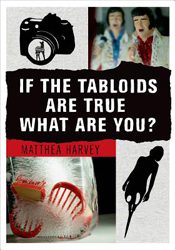
If the Tabloids Are True What Are You? is Matthea Harvey at her best – playful, intellectual and imaginative, embracing the mythology of mermaids, Martians, and scientific patents with the same verve and wit. It’s also a beautiful catalog of art work – mermaid cutout silhouettes, photographs of toy hero figurines frozen in ice, stitched diagrams of imagined inventions. As an artifact of poetry and art, as a display of the inventor’s outreaching curiosity and a publisher’s willingness to allow a poetry book to become something more – full color photographs of Harvey’s art, on lovely heavy paper – it’s pretty brilliant.
Readers tend to have one of two reactions when they read Matthea Harvey’s poetry: they either love it, or, in the words of one of my dear friends, “her work just makes me want to throw her book against a wall.” I am solidly in the camp of the former, and have been ever since I read the poems from Modern Life, her third book. You have to embrace a joyful surrealism and lack of narrative structure, a love of sonics, throw yourself into each poem’s intricate little built-up worlds, to get the most out of Harvey’s work. And I think it’s worth the effort.
The work in this book appeared in publications as varied as The New Yorker and Mermaids Magazine, just as some of the work appeared as public projects with sound, art, and interactive elements, including poetry comics and illustrations by Jeffrey Koons. To say that Harvey is pushing against the confines of poetic space would not be an overstatement – her hybrid creations are longing for life outside the page. “The Straightforward Mermaid,” for instance, was made into a short film. Here’s an excerpt, and you can see for yourself how it might lend itself to other forms:
When she is feeling despairing, she goes to eddies at the mouth of the river and tries to comb the water apart with her fingers. The Straightfoward Mermaid has already said to five sailors, “Look, I don’t think this is going to work,” before sinking like a sullen stone. She’s supposed to teach Rock Impersonation to the younger mermaids, but every beach field trip devolves into them trying to find shells to match their tail scales. They really love braiding.
If the Tabloids Are True What Are You? starts on a high note – her collection of mermaid poems – followed by a Ray Bradbury erasure, some “tabloid” worthy poems (“Cheap Cloning Process Lets You Have Your Own Little Elvis” – accompanies by photographs of a tiny toy Elvis) darts into animal parables, and illustrations of imagined constellations, and ends with the long poem tackling the rather pitiful story of an unrecognized inventor and his creations, with a background chorus of mermaid laments woven in. The techniques of prose poetry Harvey used in Modern Life, and erasure poetry in Of Lamb, as well as her signature charming use of word play and pun are all visible here.
One thing that makes this book hard to summarize is that many of the “pieces” of this book were commissioned for various public projects—and that makes the book as a whole slightly less coherent. For instance: a poem commissioned for the Poetry Radio Project – “Inside the Glass Factory” – meant to accompany Philip Glass’ “String Quartet No. 5,” next to a commission for an art show (the Bradbury erasure, “M is for Martian,”) next to the long “Telettrofono,” originally conceived as a “soundwalk”…It makes for a bit of a mixed bag, a feeling that this might be a bunch of projects tacked together rather than a thought-through whole piece. I like the carnivalesque concept of the title, which seems to give the book permission to be a looser grouping; I think it works with the strange pack of characters she creates and narrates her way around. I also like the way Harvey ties the mermaid thread from the beginning section back into “Telettrofono” at the end. Does the lack of coherence take away from the enjoyment of the book for the reader? It didn’t bother me at all the first time I read the book through, only as I approached it as a reviewer trying to dissect and discuss it, so I expect not.
 Since this review wouldn’t really be a fair assessment without some discussion of the art inside, I’d like to rave about my favorite pieces of art: Harvey’s meticulous, complicated miniature ice photos, which have a touch of despair in their whimsy: tiny male figures and chairs frozen in ice cubes upside down, suspended, as if in the middle of some important adventure and undignified in their stiff awkward poses.
Since this review wouldn’t really be a fair assessment without some discussion of the art inside, I’d like to rave about my favorite pieces of art: Harvey’s meticulous, complicated miniature ice photos, which have a touch of despair in their whimsy: tiny male figures and chairs frozen in ice cubes upside down, suspended, as if in the middle of some important adventure and undignified in their stiff awkward poses.
Though I’ve used the words “whimsical” and “playful” to describe Harvey’s work in this book, it would be a mistake to assume that the book lacks drama, mournfulness, or a sense of depth. Indeed, one of Harvey’s chief strategies is the juxtaposition of the cute with the grotesque, of horror with the unthreatening. From one of the untitled constellation poems, accompanied by a “constellation” drawing of a fox:
…No More Suicide Fox constellation looks astonishingly unadmonishing, His face is sweet and a little sad, as if he was copied from some coloring book from the fifties…We need a dog patrol that sniffs out despair and a horde of someones who will ask every single person every single day, “Are you okay?” before another friend is found dead in the bathtub, on the floor. I don’t want to talk about that fox. He’s pointing at people I love.
It’s Harvey’s obvious love of language and the cavalcade of characters, the lonely Martians, Prom Kings and despairing inventors of telephones alike, that drives the powerful engine of this ambitious and creative work. You can watch Harvey’s mind at work in the way she weaves the art with the poem, how she reflects each character’s particular mirths and misperceptions, and how she obviously identifies with her hybrid creatures, the mermaid unhappy in her birdbath in the backyard. Entering If the Tabloids Are True What Are You? is like unfolding a map to the strange and mystical in our world, unrecognized and uncelebrated until the poet discovers and reveals them.




